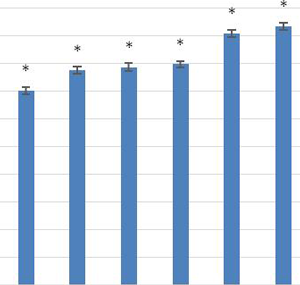Effect of the low energy electromagnetic radiation of cell phone frequency (1.8 GHz, 2.4 GHz) on the chromatin state in cells of human buccal epithelium
DOI:
https://doi.org/10.1109/ICATT.2017.7972682Keywords:
cell nucleus, heterochromatin, microwave radiationAbstract
The effect of low energy electromagnetic radiation with frequencies 1.8 GHz and 2.4 GHz on the heterochromatin granules quantity (HGQ) in the nuclei of human buccal epithelium cells was studied. Exfoliated cells were exposed to microwave radiation (frequency 1.8 GHz, surface power density 2.5 μW/cm2; and also frequency 2.4 GHZ, surface power density 2.3 μW/cm2). After exposure to microwaves during 1, 2, and 3 h, immediately or after delay of 1 or 2 h cells were stained with orcein (2% solution in 45% acetic acid). Cell exposure to microwaves induced condensation of chromatin. The biological and medical meanings of the data obtained are discussed.References
Environmental Health Criteria, vol 16, Radiofrequency and Microwaves, World Health Organization, 1981. URI: http://www.inchem.org/documents/ehc/ehc/ehc016.htm.
Exposure to high frequency electromagnetic fields, biological effects and health consequences (100 kHz-300 GHz). Review of the scientific evidence on dosimetry, biological effects, epidemiological observations, and health consequences concerning exposure to high frequency electromagnetic fields (100 kHz to 300 GHz). International Commission on Non-Ionizing Radiation Protection, ICNIRP, 2009, vol. 16. www.icnirp.org.
D. Manna, R. Ghosh, "Effect of radiofrequency radiation in cultured mammalian cells: A review,” Electromagn. Biol. Med., vol. 35, pp. 265-301, July 2016. DOI: https://doi.org/10.3109/15368378.2015.1092158.
B. Đinđić, Z. Radovanović, S. Pešić, D. Zlatanović, D. Sokolović, N. Đinđić, T. Milenković. “Cytogenetic damages induced by chronic exposure to microwave non-ionizing radiofrequency fields,” Acta Medica Medianae, vol. 52, pp. 48-52, April 2013. DOI: http://doi.org/10.5633/amm.2013.0409.
P. S. Deshmukh, K. Megha, B. D. Banerjee, R. S. Ahmed, S. Chandna, M. P. Abegaonkar, A. K. Tripathi, “Detection of low level microwave radiation induced deoxyribonucleic acid damage vis-à-vis genotoxicity in brain of Fischer rats,” Toxicology International, vol. 20, pp. 19-24, Jan. 2013. DOI: https://dx.doi.org/10.4103%2F0971-6580.111549.
G. Gandhi, G. Kaur, U. Nisar, “A cross-sectional case control study on genetic damage in individuals residing in the vicinity of a mobile phone base station,” Electromagn. Biol. Med., vol. 34, pp. 344-354, Aug. 2015. DOI: https://doi.org/10.3109/15368378.2014.933349.
J. Krebs, S. Kilpatrick, E. Goldstein, Lewin's Genes XI. Burlington, MA: Jones & Bartlett Learning, 2014.
Y. Shckorbatov, "The state of chromatin as an integrative indicator of cell stress," in: N. M. Simpson, V. E. Stewart (eds.), New Developments in Chromatin Research. New York, NY: Nova Science Publishers, 2012, pp. 123-144.
Y. G. Shckorbatov, V. N. Pasiuga, N. N. Kolchigin, et al. "The influence of differently polarized microwave radiation on chromatin in human cells," Int. J. Rad. Biol., vol. 85, pp. 322-329, 2009. DOI: http://dx.doi.org/10.1080/09553000902781113.
Y. G. Shckorbatov, V. N. Pasiuga, N. N. Kolchigin, et al. "Changes in the human nuclear chromatin induced by ultra wideband pulse irradiation," Cent. Eur. J. Biol., vol. 4, pp. 97-106, 2009. DOI: https://doi.org/10.2478/s11535-008-0051-4.
Y. G. Shckorbatov, V. N. Pasiuga, N. N. Kolchigin, Valentin Grabina, Dmitry Ivanchenko, Victor Bykov, Oleksandr Dumin, "Cell nucleus and membrane recovery after exposure to microwaves," Proc. Lat. Acad. Sci. Sect. B, vol. 65, pp. 13-20, 2011. DOI: https://doi.org/10.2478/v10046-011-0013-5.
Y. G. Shckorbatov, V. N. Pasiuga, E. I. Gonchruk, et al. "Effects of differently polarized microwave radiation on the microscopic structure of the nuclei in human fibroblasts," J. Zhejiang Univ-SCI B, vol. 11, pp. 801-805, 2010. DOI: https://dx.doi.org/10.1631%2Fjzus.B1000051.
Xiaohu Ge, Song Tu, Guoqiang Mao, Cheng-Xiang Wang, Tao Han. 5G ultra-dense cellular networks. arXiv: 1512.03143v1, December 2015.
Y. G. Shckorbatov, "He-Ne laser light induced changes in the state of chromatin in human cells," Naturwissenschaften, 86, pp. 452-453, 1999. PMID: 10501697.
I. Y. Magda, V. N. Pasiuga, E. A. Antonenko, V. A. Katrich, Y. G. Shckorbatov, "Effect of microwave radiation of GSM frequency band (1.8 GHz) on euchromatin/heterochromatin transition in isolated human buccal epithelium cells," Progress in Biomedical Engineering Research, vol. 1, No. 1, pp. 1-4, April 2015. URI: www.unitedscholars.net/archive.
Decree of the Ministry of Heals of Ukraine N 239 of 01.08.96 amended on 30.10.2007 “About ratification of the State sanitary rules and norms” (in Ukrainian). http://zakon3.rada.gov.ua/laws/show/z0488-96/page.
R. Hareuveny, R. Kavet, A. Shachar, M. Margaliot, L. Kheifets, "Occupational exposures to radiofrequency fields: results of an Israeli national survey," J. Radiol. Prot., vol. 35, No. 2, pp. 429-445, June 2015. DOI: http://doi.org/10.1088/0952-4746/35/2/429.

